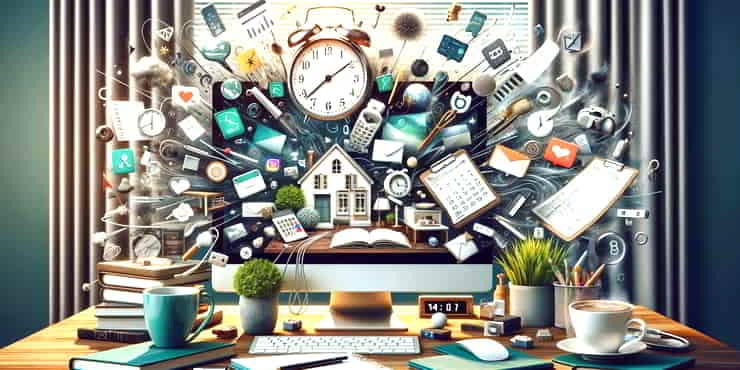Managing Interruptions: Focus Tips for Solopreneurs

Estimated reading time: 5 Min
Busy life, endless distractions? Try these focus strategies to manage interruptions and stay productive, even when you’re solo.
Interruptions have become a regular aspect of both our professional and personal lives. How we manage interruptions can significantly impact our productivity, focus, and overall well-being.
From unexpected phone calls and emails to unscheduled meetings and household emergencies, disruptions are inevitable.
Understanding and implementing strategies to handle unexpected disruptions serves to help us maintain balance in our lives as we strive towards achieving our goals.
Understanding Interruptions
Interruptions are any unexpected events that break our concentration and divert our attention from the tasks at hand.
These can range from a colleague stopping by for a chat, or a flood of notifications on our phones, to sudden thoughts about unrelated tasks. If you work from home, as I do, it can be a loved and well-meaning family member!
The psychological impact of these disruptions can be profound and often unhelpful emotions.
Research at University of California suggests that it can take between 8 and over 20 minutes to fully regain focus after an interruptions, leading to decreased efficiency and increased stress levels. In addition they found that frequent interruptions can lead to higher exhaustion, stress-induced illness, and an increase (as much as doubling) of error rates
So, constant interruptions and the struggle to refocus can have detrimental effects on our performance and mental health.
Types of Interruptions
Interruptions can broadly be classified into two categories: external and internal.
External interruptions come from our environment, such as phone calls, emails, or interactions with others.
Internal interruptions, on the other hand, stem from our own thoughts and impulses, such as the urge to check social media or the sudden remembrance of a different task.
Technology can play a significant role in both types of interruptions.
While it has revolutionised the way we work and communicate, it has also introduced a myriad of distractions.
Email alerts, social media notifications, and instant messaging apps constantly vie for our attention, disrupting our focus and fragmenting our time.
Strategies for Managing Interruptions
Successfully managing interruptions involves a combination of prioritising, scheduling, and boundary setting as follows:

- Prioritisation and Scheduling
One of the first steps in managing interruptions is to identify which are worthy of immediate attention and which can wait. This involves understanding the urgency and importance of the tasks at hand and of the interruptions themselves. Techniques such as the Eisenhower Box can be helpful in categorising tasks and disruptions accordingly. Obviously perhaps, priorities need to be considered before an interruption. At the time when an interruption occurs, it’s too late. - Setting Boundaries
Communicating your availability to colleagues, friends, and family can significantly reduce unnecessary interruptions. This might involve setting specific hours for deep work where you are not to be disturbed, except for emergencies. Similarly, utilising “Do Not Disturb” modes on devices can help minimise digital disruptions. - The Power of a Schedule
Allocating specific times for checking emails, taking calls, or engaging in spontaneous discussions can help protect your focus. By scheduling time for potential interruptions, you can create a balance between being accessible and maintaining productivity. Furthermore, dedicating blocks of time to specific tasks allows for deeper concentration, reducing the impact of disruptions when they do occur. - Pomodoro technique
The pomodoro technique is used to help you focus for short periods of time. You can learn about the Pomodoro Technique here. If you let people know you’re using the Pomodoro Technique and how it works they are more likely to wait until you take a break before talking with you.
These strategies form the foundation of a proactive approach to managing interruptions.
By recognising the possible types and sources of disruptions early and implementing these techniques, individuals can take significant steps towards safeguarding their productivity with much less stress than otherwise.
Tools and Techniques to Minimise Disruptions
In the quest to minimise disruptions, several tools and techniques stand out for their effectiveness in enhancing focus and productivity:
- Technology Solutions
Numerous apps and software have been designed to help manage interruptions. Tools like Focus@Will offer music designed to enhance concentration, while apps such as Forest encourage users to stay off their phones by gamifying the process of focus. Additionally, website blockers can temporarily restrict access to distracting sites during work hours. - Environmental Adjustments
Optimising your physical workspace can also play a crucial role in minimising interruptions. This might involve wearing noise-cancelling headphones in a busy office or setting up a dedicated, quiet space for work at home. The key is to create an environment that supports concentration and minimises the likelihood of external disruptions. - Mindfulness and Resilience Training
Developing personal skills to calmly manage interruptions when they occur is equally important. Mindfulness practice can help individuals regain focus more quickly after being interrupted, while resilience training can improve one’s ability to handle disruptions without significant stress. Practices such as meditation and deep-breathing exercises can enhance one’s ability to stay calm and focused amidst distractions.
Implementing a Personal Interruption Management Plan
Creating a plan of your own to manage interruptions involves several steps, each tailored to individual needs and circumstances:
- Assessment
Begin by tracking the frequency, source, and type of interruptions you face. This can help identify patterns and the most disruptive elements in your environment. - Strategising
Based on your assessment, employ the strategies discussed earlier. Prioritise tasks, set clear boundaries, and schedule your day to accommodate both focused work and potential interruptions. - Routine and Habits
Incorporate your strategies into a daily routine. Consistency will turn these practices into habits, reducing the effort required to maintain them over time. - Evaluation
Regularly review the effectiveness of your plan. Are you experiencing fewer disruptions? Are you able to refocus more quickly after an interruption?
Adjust your strategies as needed to improve your control over interruptions.
Summary
Managing interruptions is an ongoing challenge that requires awareness, strategy, and adaptability and emotional control.
By understanding the types of disruptions you face and employing a mix of time management, boundary setting, and mindfulness techniques, you can significantly reduce their impact on your productivity and well-being.
Remember, the goal is not to eliminate all interruptions but to develop a robust system that allows you to handle them effectively.
If something isn’t working well, fine-tune your approach, and you’ll find yourself handling interruptions with greater ease and resilience, leading to a more calm, productive and satisfying daily life.
OK… if you have something to add or ask questions about, please use the comments section or the contact form.
🙂
Richard






